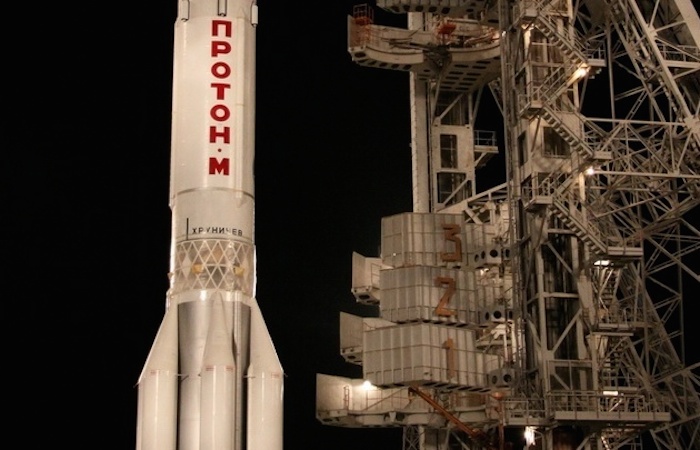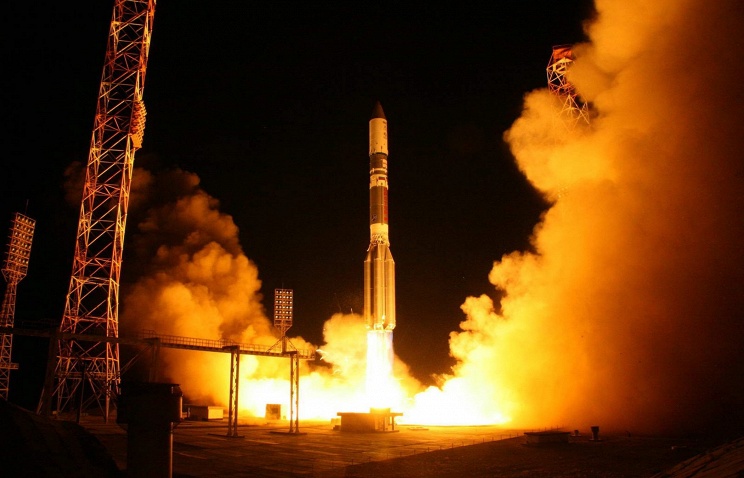.

Proton-M carrier rocket lifts off from Baikonur
“The Russian satellite is expected to enter the final CALCULATED orbit at 09:26 Moscow time (on Sunday),” the press service of the Russian Space Agency (Roskosmos) reported.
.
The Proton-M carrier rocket, which lifted off from Baikonur space launch facility early on Sunday, has put the Briz-M rocket booster and the Russian RELAY satellite Luch in the interim orbit, the press service of the Russian Space Agency (Roskosmos) reported.

“The Russian satellite is expected to enter the final CALCULATED orbit at 09:26 Moscow time (on Sunday),” the press service said.
The Luch spacecraft is another satellite of the Luch Multifunctional RELAY System which is being developed under the 2006-2015 Russian federal space programme. The Luch RELAY system is intended to provide the Russian segment of the International Space Station /ISS)/; low-orbiting space devices; boosters and upper stages with communication with ground-based facilities. The previous Luch spacecraft - Luch-5B - was successfully put in orbit on April 28 this year.
Quelle: ITARTASS
.
Russian relay satellite enters calculated orbit

Russian RELAY satellite Luch, launched by the Proton-M carrier rocket from Baikonur space launch facility early on Sunday, has separated from the Briz-M rocket booster and reached the calculated orbit, the press service of the Russian Space Agency (Roskosmos) reported on Sunday.
“The space apparatus has separated in scheduled time,” the press service said.
It was this years’ fifth launch with use of the Proton carrier and the first launch after the accident with the carrier. On May, Proton-M with the Express-AM4R communication satellite took off from Baikonur, and later on burned down in the dense layers of the atmosphere.
The Luch spacecraft is another satellite of the Luch Multifunctional RELAY System which is being developed under the 2006-2015 Russian federal space programme. The Luch relay system is intended to provide the Russian segment of the International Space Station (ISS); low-orbiting space devices; BOOSTERSand upper stages with communication with ground-based facilities.
The Russian segment of the International Space Station (ISS) can communicate directly with the mission control centres in Russia and in the U.S. for 2.5 hours a day. For communication outside the time limit, Russia buys services of the U.S. Tracking and Data RELAY Satellite System.
The previous Luch spacecraft - Luch-5B - was successfully put in orbit on April 28 this year.
Quelle: ITARTASS
.
Proton rocket lifts off on return-to-FLIGHT mission
A Russian Proton rocket blasted off Saturday with a secret military satellite, returning to flight status after a four-month grounding following a launch failure in May.
The three-stage BOOSTER, topped with a Breeze M upper stage, launched at 2023 GMT (4:23 p.m. EDT) Saturday, or 2:23 a.m. local time at the historic Baikonur Cosmodrome in Kazakhstan, according to Roscosmos, the Russian Federal Space Agency.
The Proton BOOSTER released the launcher's Breeze M upper stage about 10 minutes after liftoff to begin a series of maneuvers to propel the mission's payload into orbit thousands of miles above Earth.
The Proton rocket will deploy a secretive Russian military satellite called Luch at 0526 GMT (1:26 a.m. EDT), Roscosmos said in a post on its WEBSITE.
Russia has revealed little about the mission -- also known as Olymp -- other than the spacecraft was built by ISS Reshetnev, a Russian satellite manufacturer.
The satellite is likely heading for geostationary orbit, a 22,300-mile-high perch used by communications satellites, where a spacecraft's orbit matches the speed of Earth's rotation.
Saturday's launch was the first FLIGHT of a Proton rocket since a launch failure in May.
Investigators traced the cause of the May 15 failure to the premature shutdown of the Proton rocket's third stage engine. News reports after the launch blamed the problem on an anomaly in the third stage's steering system.
The Express AM4R communications satellite was lost in the launch mishap.
Russian officials delayed the launch of the Luch satellite four months after the May 15 failure.
The next Proton mission after Saturday is set for Oct. 21 with the Express AM6 satellite, a civilian telecommunications spacecraft for the Russian Satellite Communications Co.
Commercial flights of the Proton rocket, MANAGED by U.S.-based International Launch Services, are scheduled to resume later this year.
The ASTRA 2G communications satellite, owned by SES of Luxembourg, is the next commercial payload on the ILS manifest.
Troubled by reliability concerns and deteriorating relations between Russia and Western governments, ILS announced a staff cut of 25 percent in August to align with an expected reduction in launch business.
Phil Slack, president of ILS, said the layoffs would make the company's workforce consistent with three or four commercial Proton launches per year, down from up to eight ILS missions annually under previous forecasts.
The Proton rocket's performance is best suited to launching large telecommunications satellites weighing more than 6,000 kilograms (13,227 pounds).
But launch contracts for commercial telecom satellites of that size have mostly gone to SpaceX and Arianespace this year.
Quelle: SN
4573 Views
